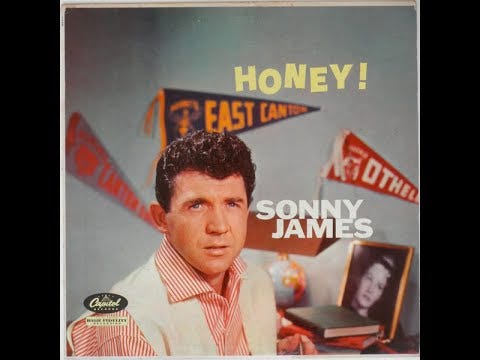Sonny James – “Over Somebody Else’s Shoulder” 1958 from Honey! Here’s a song that was originally popularized in 1934 by Ozzie Nelson. That was a year before he married Harriett. It was written by Al Sherman and Al Lewis, two proficient songwriters in the Tin Pan Alley world whose oeuvres have largely disappeared, though Lewis did alright for himself when he came up with the words to “Blueberry Hill.” Sonny James was a country singer who clearly loved the pop music of his youth – he was 6 years old when Nelson recorded this song. So, why not do a New York-styled peppy arrangement of an old standard? I love it myself – the vibraphone arpeggios, the smooth backing vocals, the swinging brushes on drums, and the Nashville guitar chords thrown in here and there. The song is sung from the point of view of a total dick – he’s dancing with one woman and falling in love with some other one across the room. I’m not saying this kind of thing never happened, but come on – “The moment I spot your charms I was in danger / The girl in my arms became a total stranger”? I just feel bad for his dance partner.
R.E.M. “High Speed Train” 2004 from Around the Sun. By 2004, and honestly for several years before, I would dutifully but with no expectations give a listen to each R.E.M. album when they came out. Then I would file them away just because I was a completist and had all the albums since back in the days when they were essential listening. So, what this means today is that I think I’ve only heard this song once before in my life. It’s a mesmerizing ditty, built on feedback drones and a steady limited melodic intonation of love from Michael Stipe. I mean, who hasn’t made a sudden connection with another person while thinking “I felt like the antelope / Who jumped from the building”? Mike Mills echoes those lines as well as the other half of the chorus, and Peter Buck plays all sorts of guitar parts, including a lovely chorus on a classical acoustic guitar. It’s a beautiful song in a post-Radiohead sort of approach, and I wish I had paid closer attention when it was new. I wonder how many other gems are hidden on those later R.E.M. records.
King Curtis – “Soul Serenade” 1964 from Soul Serenade. Every time I hear a version of this song, I think back to the first time I heard it, which was the first time I saw St. Louis r&b legend Oliver Sain. His version began with several minutes of ecstatic gospel-inspired solo saxophone bursts, and I was busy picking my jaw off the floor throughout the entire performance. And when he finally burst into the actual tune with the full band, it was one of the greatest releases of tension in music I ever experienced. But the original version dates back to this 1964 release from the great King Curtis. It’s much smoother and more seductive than later recordings even by Curtis. He was playing a B-flat saxello, and no, I don’t know any other references to this alto sax family member. Piano, guitar, bass, and drums offer accompaniment somewhere near country sounds of the day – the pianist sounds like he studied Floyd Cramer. It gets faster as it goes along, and Curtis hits some high notes, and starts screaming a little bit, then wobbles between two notes for a long time just before the fade. You can’t go wrong with this song.
Miles Davis – “Buzzard Song” 1959 from Porgy and Bess. Drop the needle on this classic collaboration between Miles Davis and arranger Gil Evans, and the first thing you’ll hear is a shrill blast of brass, quickly operating in counterpoint with the reed section of a big band. They chose to adapt George Gershwin’s opera out of order. “Buzzard, Keep on Flying” is the first song of Act 2 in the original. I guess they figured without lyrics comparing the buzzard to the dark hand of fate and then telling fate that Porgy doesn’t live here anymore, they might as well change the title, too. Flutes and piccolo gently ease us out of the opening, and then Miles plays the tune with characteristic aplomb, showing off the sweetness of his tone while the band accompanies him carefully. When it’s time for improvisation, the rhythm starts swinging, and the horns carry on a constant beating set of chords before the band starts swelling up as Miles reaches higher notes. Just over halfway through, the melodic interest is given to the bass and tuba. Gil Evans, man! That guy was one heck of an inventive arranger.
Dave Edmunds – “I’m Coming Home” 1971 from Rockpile. This was actually the second single Dave Edmunds released, and why the record company actually thought this could be a hit to follow up “I Hear You Knockin’” is beyond imagination. Of course, in 1971, there were more explicitly religious songs than this one breaking through to the pop charts. Edmunds takes an old spiritual and turns it into a rockabilly rave-up with about fifteen overdubbed guitars with even the bass guitar sounding trebly. I’m not sure how Edmunds could relate to dreaming of heaven while working in the cotton fields, but I don’t think it matters much. After the initial slow verse, this record is all about being loud and fast and giddy.


